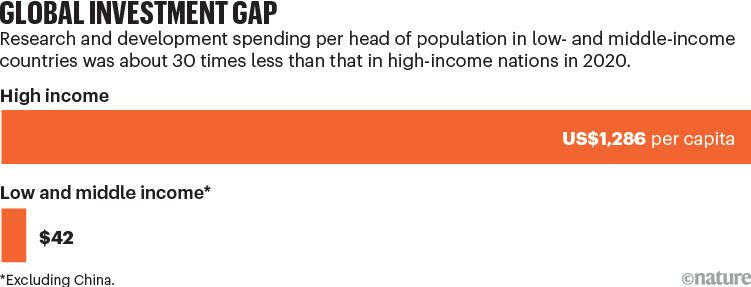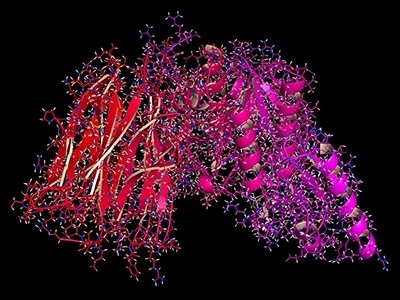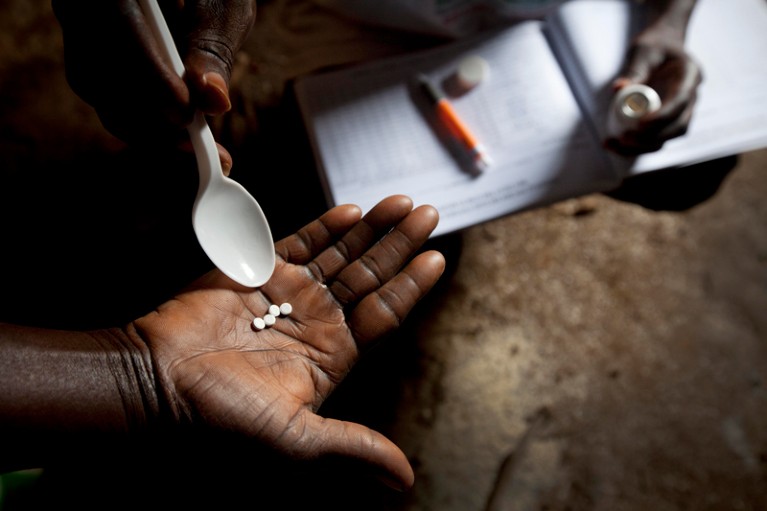Each year, businesses and governments worldwide invest more than US$2 trillion in research and development (R&D) projects. Yet investments in innovations that are intended to help the world’s poor people are meagre. In 2020, R&D expenditure in high-income countries (HICs) amounted to $1.6 trillion, 74% of the total (see go.nature.com/3kmk9qd). Yet those countries have a combined population of just 1.2 billion — 15% of the world’s total. Exclude China, and in 2020 just $224 million was spent on R&D in low- and middle-income countries (LMICs) that are home to 5.3 billion people (see ‘Global investment gap’).
Most of the benefits of R&D investment in HICs stay in HICs1 (see also go.nature.com/3jnngyu). LMICs might gain from, for example, new treatments for cancer, diabetes, COVID-19 and HIV/AIDS, or improved mobile phones that are made for global markets. Yet technologies developed in HICs are often mismatched with the needs of LMICs2. Some of those needs are distinctive: for example, vaccines for common tropical diseases, drought- and flood-resistant crops suited to the ecologies of LMICs, and off-grid renewable energy sources.

Source: World Bank Open Data (https://data.worldbank.org)
From the perspective of businesses in rich countries, it is not profitable to cater to populations that cannot afford to pay for discoveries. And many LMIC economies are risky to invest in, owing to unstable governments or weak enforcement of intellectual property (IP) rights, for example.
States, aid agencies and philanthropic organizations help to fund R&D, but their contributions account for less than one-third of all R&D spending, little of which is targeted at LMICs, and are unlikely to increase much.
The greatest untapped potential lies in harnessing private-sector investment by making it profitable for companies to develop innovations targeted to the needs of LMICs. New approaches are sorely needed.
Here, I propose one option: what I call benevolent patent extensions. Requiring a relatively simple extension to IP law, these could allow businesses to trade off value between patents and thereby boost investments to meet the agricultural, biomedical and other essential needs of people living in poverty.
Lots has been tried, little has worked at scale
Table of Contents
First, why are new approaches needed? In a nutshell, existing efforts are falling short.
Although some governments and foundations have introduced schemes to encourage private R&D investment in LMICs, these tend to be small-scale and of limited impact. Funding is typically short term, making future financing unpredictable.
Cash prizes have been given for discoveries that meet specified criteria, such as high yields for new crop varieties, or vaccine efficacy3. Another incentive takes the form of ‘advance market commitments’ to purchase new products that are intended for LMICs, guaranteeing inventors a market large enough to cover their R&D costs. In 2007, for example, a $1.5-billion pledge by the Bill & Melinda Gates Foundation in Seattle, Washington, and five governments to purchase pneumococcal vaccines appropriate to LMICs generated 3 new vaccines that immunized 150 million children, saving an estimated 700,000 lives4. Both cash prizes and advance market commitments are constrained, however, by limited public or philanthropic funding and the credibility of sponsors’ promises.

Artificial intelligence is breaking patent law
Then there are social impact bonds. These enable public agencies to raise funds partly supported by the promise of sharing future cost savings with investors, provided that the innovation financed by the bond meets specified metrics to benefit society. For example, in 2013, one such bond in Fresno, California, financed in-home preventive care for children who had moderate to severe asthma and were from low-income families. Investors were promised higher payments the greater the improvements in child health outcomes that reduced public health-care costs5.
Humanitarian-use licences from patent holders allow LMIC-based licensees to use proprietary technologies at a heavy discount. Such licences are useful when a discovery has unintended, alternative uses that can benefit poorer populations. For example, plant breeders in LMICs can access IP-protected golden rice — a variety biofortified to reduce vitamin A deficiency — for free to enable breeding of new varieties for use in poor rice-growing regions. But because these merely grant a licence for humanitarian use of a technology developed for a different clientele, this tool creates no incentive to invest in innovations intended to benefit poor people.
Humanitarian-use licences do not work well for vaccines for neglected tropical diseases or for plant breeding of niche crops such as teff (Eragrostis tef) or cowpea (Vigna unguiculata), or even to improve staple crops such as maize (corn), rice, sorghum, soya bean or wheat, owing to differences in agricultural and disease ecologies between HICs and LMICs. Staple-crop cultivars that were developed in HICs but are inappropriate for low-income tropical agriculture, for example, reduce global productivity by an estimated 58%6.

How ‘research impact bonds’ could transform science funding
Finally, priority review vouchers are used in the United States to incentivize research to develop drugs for rare paediatric or tropical diseases. Developers receive a tradable voucher that accelerates regulatory review of some other patented drug by several (typically four) months7. The US Food and Drug Administration (FDA) issues these, but currently just for 27 tropical diseases. It’s unclear how effective the vouchers have been since their 2009 introduction8,9. Furthermore, such vouchers are restricted to pharmaceuticals and are thus of no use in developing techniques for low-income agriculture or sectors such as energy.
A better option has been hiding in plain sight.
Benevolent patent extensions — a simple but effective idea
The guiding principle of IP rights, embodied in patents (or copyright), is to assign an inventor monopoly powers over a novel, non-obvious, useful discovery for a set period. Governments award these rights in exchange for the inventor making the details publicly available, to facilitate other discoveries. The inventor’s monopoly allows them to recoup development costs through prices that are higher than they would otherwise be in a competitive market. Incentives for developers through IP thus depend mainly on the monetary scale — not the population head count — of the target consumer market.
The basic idea of a benevolent patent extension is straightforward. An inventor who applies to patent a ‘benevolent discovery’ — one that targets LMICs’ needs — is given the opportunity to offset the R&D costs by extending another patent, for a ‘non-essential’ product. The condition is that the benevolent discovery be offered to the public for unrestricted, non-exclusive, global use, royalty-free for the duration of its patent.

Turkana tribespeople pick cowpea leaves on a farm near Kakuma Refugee Camp in northern Kenya, where many people are undernourished.Credit: Dai Kurokawa/EPA-EFE/Shutterstock
The patent-granting authority — in the United States, the Patent and Trademark Office — would extend the non-essential patent by a duration equivalent, in terms of expected revenue over the period, to the estimated social value of the benevolent discovery. Thus, the costs of releasing the benevolent discovery to low-income buyers of seeds, medicines and vaccines would be borne by affluent consumers of other, non-essential, products, such as phone apps, consumer electronics and cosmetics.
The benevolent discovery would still need to pass safety and effectiveness tests conducted by authorities such as the FDA. Breaching the terms would immediately forfeit both the benevolent patent and the extension, thus releasing both discoveries into the public domain.

Antibody-patent row could have far-reaching impact on biotech
The public-use condition would ensure widespread, low-cost availability of benevolent discoveries, whereas regulatory review of technologies and values would minimize attempts by companies to use ineffective or untested discoveries to extend profitable patents and thus game the system.
Can such trade-offs cover the costs? Absolutely. A 2008 study put the mean value of a European patent at €3 million (US$3.2 million), and many non-essential patents generate profits of hundreds of millions of dollars annually10. The value of a few months or years of extra patent protection on, for example, popular business software or a cosmetic would, under a benevolent extension, become that of the benevolent discovery, such as an effective vaccine for schistosomiasis (bilharzia) or a variety of drought-resistant cassava (Manihot esculenta) or teff, for which the commercial market would otherwise be scant.
Benevolent patents could be traded to ensure that small enterprises with no existing patents could tap this tool, by selling benevolent discoveries to big companies holding large patent portfolios that might not be in the same industry as the discovery.
Define and regulate patent extensions
The definition of a ‘benevolent discovery’ is crucial. It should relieve human suffering, especially in poor populations, and generate societal benefits that far exceed any commercial profit the invention might earn. Researchers would need to establish a benevolence standard that such technologies should meet. This would require them to pay greater attention to equity issues in valuation, such as who benefits. It would also create commercial incentives to improve social valuation methods, which would have broad applications in environmental, health and other domains.
As happens now, regulatory bodies such as the FDA would review the research evidence produced (and financed) by the patent owner to establish the safety and effectiveness of the discovery. The new twist would be the assignment of an estimated monetary value to the benevolent discovery. This task is best tackled by an expert panel, perhaps convened under the auspices of an official scientific body, such as the US National Academies of Sciences, Engineering, and Medicine.
Valuation would follow best scientific practices. For biomedical discoveries, for example, that would mean estimating the gain in ‘disability-adjusted life years’ — a measure of disease burden — in LMICs11, multiplied by the annual average income of working-age adults in the country awarding the patent. For agricultural discoveries, using global market prices to value productivity gains would overcome market distortions in many LMICs owing to poverty12.

Benevolent patent extensions can induce research and development of drugs that benefit people in low- and middle-income nations.Credit: Kate Holt/eyevine
The patent-granting authority would publish a list of non-essential patents eligible for extension. Patent holders could petition to include a discovery on the list, reducing the burden on offices to identify eligible ones. The patent authority would invite public comment on any such petition for a minimum period — say, 60 or 90 days — after which it would accept and list undisputed petitions.
Consumers, or prospective competitors disputing a petition, must establish that the patent in question is essential to the preservation of an active, healthy life. Disputed petitions would pass to an independent review authority — perhaps convened by a national science body — for an authoritative recommendation before the patent authority makes a decision.
The patent authority would decide how long to extend the patent on the non-essential discovery, on the basis of the independent review authority’s valuation of the benevolent discovery, divided by the annual sales of the non-essential patented product. This could be based on the preceding two years’ audited sales records, and the extension could be limited to some maximum (say, ten years), to guard against excessive generosity.
Consider other advantages
Benevolent patent extensions don’t require significant changes to IP law. Most countries already allow a patent’s term to be extended beyond the usual statutory grant, for example to account for delays in processing a patent application.

Allow patents on AI-generated inventions — for the good of science
If the patent owner violates the public-use condition, any remaining extension on the patent life would terminate immediately. And if the R&D investment fails to generate a benevolent discovery of social value, then the option has no value. Thus failures will not be rewarded.
Benevolent patent extensions are thus a redistributive way to induce R&D investment. Insofar as some wealth and income inequality in the world has unjust origins (stemming from colonial conquest, illegal activities or slavery, for instance), such extensions would provide a voluntary, market-mediated mechanism to provide some restitution.
Importantly, no inventor would be obliged to surrender their IP and no consumer would be obliged to purchase goods or services that receive extended patent protection. An inventor whose discovery proves profitable in LMICs could still pursue, and enforce, a patent in those nations if they choose not to request a benevolent patent extension.
Nor would benevolent patent extensions close off commercial distribution of any new discovery. They would merely offer the option to boost the value of a benevolent discovery through the transfer of patent protection to a different, non-essential, discovery with an established market among high-income consumers. Purchasers of non-essential goods and services would still enjoy their benefits, even if they have to continue to pay the prevailing, marked-up price for a longer period.
There might be some losers: for example, when the patent on the non-essential discovery expires, new producers could enter the market and undercut prices. Prospective consumers who are aware of the patent might therefore prefer to wait until the monopoly period ends and prices fall. They would have to wait longer if that patent got extended. Market entrants would also need to wait longer to be able to profit. Such hypothetical losses could be minimized by permitting extensions of protection only for patents that are more than, say, one year from expiration.
Watch investments grow
Benevolent patent extensions would be wholly private investments. They would thus complement prizes, advance market commitments, bonds and other existing tools used by governments and philanthropies to promote socially beneficial R&D.

How a controversial US drug policy could be harming cancer patients worldwide
Through trading, extensions would spread to companies in many sectors. For example, a software developer or device manufacturer could contract with a non-profit organization such as the CGIAR — the global network of agricultural research centers — to invest in a new variety of drought-resistant teff. The contract would require the inventor to pursue a benevolent patent extension when seeking IP on a discovery, and then to transfer the extension to the investor. Such arrangements could unlock tens, even hundreds of billions of dollars in corporate cash for investment in benevolent discoveries.
Local exploration and experimentation that involve working directly with affected human populations or under suitable agroecological or epidemiological conditions would be crucial for acquiring benevolent patents. More investment would thereby build capacity in R&D laboratories and scientific staff in LMICs, raising productivity and economic growth as well as reducing disease and poverty.
Currently, the owners of soon-to-expire patents invest massively in minor improvements that might permit them to replace those patents, as well as in planned obsolescence of the patented product. Benevolent patent extensions would offer an alternative, more socially beneficial way for companies to invest ethically in R&D. There will be other ideas, but the more tools available, the better.
Next steps to roll-out
Advancing this idea requires deliberation and authorization. Regulatory and scientific bodies must collaboratively determine the methods, definitions and standards that would underpin the ‘benevolent’ and ‘non-essential’ criteria, and the social value of benevolent patents. Firms and governments might use forums such as the G20 grouping of countries and the World Economic Forum, which focuses on public–private cooperation, to discuss and refine the idea. Finally, lawmakers must explicitly authorize patent offices to award benevolent patent extensions. A modest update to existing patent law could unlock considerable private funding to help the world’s poor people.
